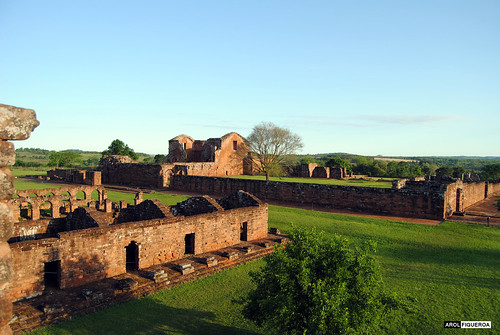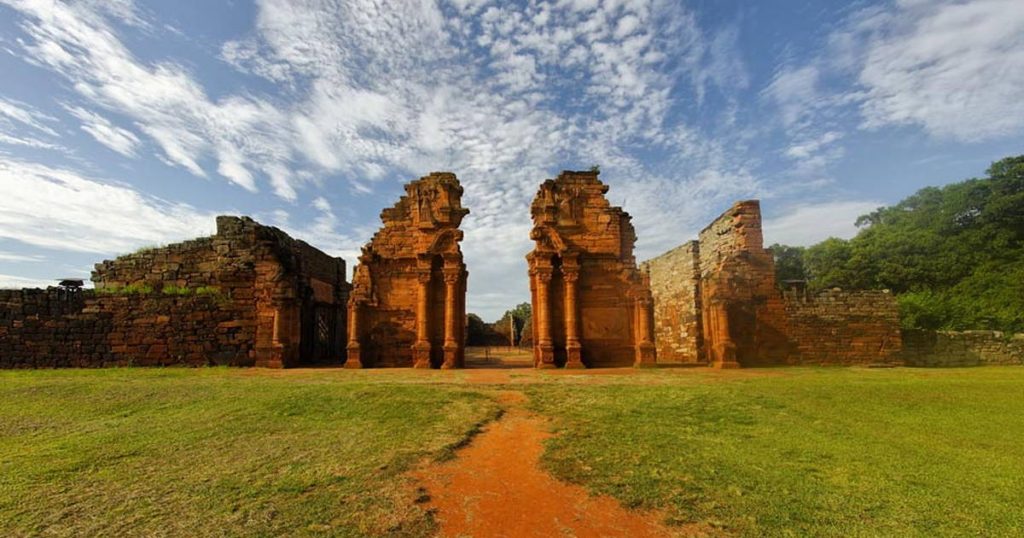
The Jesuit Mission in South America started in 1534 when the Company of Jesus (La Compañía de Jesús) was founded by Saint Ignacio de Loyola. This company was approved by the Catholic Pope Paulo III in 1540. Unlike other Spanish and Portugese conquerors, these Jesuit missionaries did not participate in the conquest of South America. Instead, the first Jesuit mission group settled in the tropical area of South America, where it is located in the modern day Paraguay, Brazil and Argentina borders. Up to the year of 1709, there were 15 Jesuit settlements in Northeast Argentina with 12 towns located in the Misiones Province and 3 were in Corrientes Province. Under the leadership of the Priest Diego de Torres, he believed that the tribute and reduction or Jesuit mission systems were incompatible. When the Guarani people and priests first encountered each other, they were both very cautious and skeptical of each other. Gradually, with more interactions, the Guarani people started to accept Christianity and changed their form of living. The reduction system was implemented to govern the territories, guaranteed the autonomy of Guarani people and isolated the Jesuit territories from the colonial society with a new social and religious order. In the reduction territories, Guarani tribes kept their own language and learned Christianity in Guarani as well. Under this form of voluntary evangelization, Guarani tribes had learned to write and used advanced Math in their system. At the same time, the Guarani people learned Spanish and Latin. The priests who lived in those reduction towns supervised residents’ daily activities such as misa and agricultural works. The Jesuit evangelization reorganized the Guarani community culturally and religiously, as they mixed European and Guarani instruments to sing songs and create theater shows to celebrate God.

This photo presents the current ruins of the Jesuit mission in San Ignacio, Misiones, Argentina. This site is located in the middle of the tropical forest. A Jesuit town normally consisted of a Catholic church, houses for priests and Guarani residents, a school and a plaza that marked as the center of a town. The ruins of San Ignacio shows the economic, religious and political structure of a reduction system during the colonial era. As the Treaty of Madrid came into in 1750 effect as a result of territorial dispute between the Portuguese and Spanish colonizers, the East side of the American territory was under Portuguese control. The Guarani and priests did not accept the new authority and the plan of converting Guarani people into slaves because they were regarded as animals from Portugueses’ perspective. In 1767, Catholic priests were forced out of the reduction territories, which marked the end of the Jesuit mission.This Jesuit town was burnt down by the Portuguese, and many Guarani people were slaughtered.
Jesuit mission in South America presents the division in the Catholic church, as one branch of the Catholic church implemented a model of voluntary evangelization. The ruins of San Ignacio showed an example of coexistence between the European priests and indigenous tribes in Colonial Latin American history. There are other sources to show the impact of the Jesuit Mission in South America such as the Iguazu Falls, which “Iguazu” means big water in Guarani. One Argentine province that shares borders with Paraguay and Brazil is named as “Misiones”. Another controversial historical event is the debate of Valladolid in 16th Century Spain took place when Sepúlveda and Las Casas discussed whether Spain had the right to conquer the Americas. Sepúlveda argued that the conquest was a “just war” because the indigenous people were barbaric and had anti-natural behaviors, and the Spanish people were superior to them. Thus, the Spanish conquerors were obligated to “civilize” the indigenous population. Las Casas defended his position of voluntary evangelization and questioned the definition of “barbarie”. From the Jesuit Mission in South America, we could see Las Casas’s ideas were implemented in the tropical region, as the priests believed in the ownership of Guarani territories and humanity of those indigenous people. From a historiographical perspective, it is noticeable that the right to conquer the Americas has been controversial, as some Iberians used religion to reorganize indigenous society with a new faith. A question about whether Jesuit mission is another form of colonization should be considered, as the Guarani accepted more European cultures in one century. Some people said the Jesuit mission was not colonization, but a cultural syncretism while others believed that the mission was just another form of colonization with the priests preaching their ideas and changing their original culture.
References:
Córdoba Toro, Julián. “Misiones jesuíticas guaraníes.” Iberoamérica Social (Jan 21, 2018). https://iberoamericasocial.com/misiones-jesuiticas-guaranies/. Accessed March 1, 2020.
“Jesuit Missions of the Guaranis: San Ignacio Mini, Santa Ana, Nuestra Señora de Loreto and Santa Maria Mayor (Argentina), Ruins of Sao Miguel das Missoes (Brazil). ” UNESCO. https://whc.unesco.org/en/list/275/. Accessed March 2, 2020.
“Misiones Jesuíticas de los Guaraníes.” EcuRed. https://www.ecured.cu/Misiones_Jesu%C3%ADticas_de_los_Guaran%C3%ADes. Accessed March 2, 2020.
Wilde, Guillermo. “Guaraníes y jesuitas en la imaginación histórica moderna.” Harvard Review of Latin America (2015). https://revista.drclas.harvard.edu/book/guaran%C3%ADes-y-jesuitas-en-la-imaginaci%C3%B3n-hist%C3%B3rica-moderna-0. Accessed March 2, 2020.
Wallerstein, Immanuel. “¿Injerencia en los derechos de quién? Valores universales vs. Barbarie” in Universalismo Europeo: El discurso del poder. Siglo Veintiuno editores (2007). Accessed Feb 22, 2020.
Viñuales, Graciela María. “Misiones jesuíticas de Guaraníes (Argentina, Paraguay, Brasil).” Apuntes vol. 2, no. 1: 108-125 (2007). Accessed March 2, 2020. http://www.scielo.org.co/pdf/apun/v20n1/v20n1a07.pdf
Manerno Salvador, Ana. (2009). La Controversia de Valladolid: España y el análisis de la legitimidad de la conquista de América. Revista Electrónica Iberoamericana, 3(2). Accessed Feb 22, 2020.
